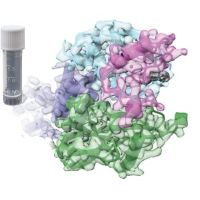Specification
| Description | Recombinant protein from the full-length sequence of Homo sapiens transglutaminase 2 (TGM2), transcript variant 2 (NM_198951). |
| Organism | Homo sapiens (Human) |
| Expression Host | Human Cells |
| Tag Info | His or DYKDDDDK. Please contact us if you need further information or require specific designed tag. |
| Purity | Greater than 90% by SDS-PAGE gel |
| Uniprot ID | P21980 |
| Entry Name | TGM2_HUMAN |
| Gene Names | TGM2 |
| Alternative Gene Names | |
| Alternative Protein Names | Protein-glutamine gamma-glutamyltransferase 2 (EC 2.3.2.13) (Erythrocyte transglutaminase) (Heart G alpha(h)) (hhG alpha(h)) (Isopeptidase TGM2) (EC 3.4.-.-) (Protein G alpha(h)) (G(h)) (Protein-glutamine deamidase TGM2) (EC 3.5.1.44) (Protein-glutamine dopaminyltransferase TGM2) (EC 2.3.1.-) (Protein-glutamine histaminyltransferase TGM2) (EC 2.3.1.-) (Protein-glutamine noradrenalinyltransferase TGM2) (EC 2.3.1.-) (Protein-glutamine serotonyltransferase TGM2) (EC 2.3.1.-) (Tissue transglutaminase) (tTG) (tTgase) (Transglutaminase C) (TG(C)) (TGC) (TGase C) (Transglutaminase H) (TGase H) (Transglutaminase II) (TGase II) (Transglutaminase-2) (TG2) (TGase-2) (hTG2) |
| Application | Antigens, Western, ELISA and other in vitro binding or in vivo functional assays, and protein-protein interaction studies; For research & development use only! |
| Buffer | Purified protein formulated in a sterile solution of PBS buffer, pH7.2, without any preservatives |
| Endotoxin | Endotoxin level is < 0.1 ng/µg of protein (<1EU /µg) |
| Length | 687 |
| Molecular Weight(Da) | 77329 |
| Protein Sequence | (The sequence of expressed protein may have some variation from the sequence shown below. Please contact us for the exact sequence.) MAEELVLERCDLELETNGRDHHTADLCREKLVVRRGQPFWLTLHFEGRNYEASVDSLTFSVVTGPAPSQEAGTKARFPLRDAVEEGDWTATVVDQQDCTLSLQLTTPANAPIGLYRLSLEASTGYQGSSFVLGHFILLFNAWCPADAVYLDSEEERQEYVLTQQGFIYQGSAKFIKNIPWNFGQFEDGILDICLILLDVNPKFLKNAGRDCSRRSSPVYVGRVVSGMVNCNDDQGVLLGRWDNNYGDGVSPMSWIGSVDILRRWKNHGCQRVKYGQCWVFAAVACTVLRCLGIPTRVVTNYNSAHDQNSNLLIEYFRNEFGEIQGDKSEMIWNFHCWVESWMTRPDLQPGYEGWQALDPTPQEKSEGTYCCGPVPVRAIKEGDLSTKYDAPFVFAEVNADVVDWIQQDDGSVHKSINRSLIVGLKISTKSVGRDEREDITHTYKYPEGSSEEREAFTRANHLNKLAEKEETGMAMRIRVGQSMNMGSDFDVFAHITNNTAEEYVCRLLLCARTVSYNGILGPECGTKYLLNLNLEPFSEKSVPLCILYEKYRDCLTESNLIKVRALLVEPVINSYLLAERDLYLENPEIKIRILGEPKQKRKLVAEVSLQNPLPVALEGCTFTVEGAGLTEEQKTVEIPDPVEAGEEVKVRMDLLPLHMGLHKLVVNFESDKLKAVKGFRNVIIGPA |
Background
| Function | FUNCTION: Calcium-dependent acyltransferase that catalyzes the formation of covalent bonds between peptide-bound glutamine and various primary amines, such as gamma-amino group of peptide-bound lysine, or mono- and polyamines, thereby producing cross-linked or aminated proteins, respectively (PubMed:9252372, PubMed:23941696, PubMed:31991788). Involved in many biological processes, such as bone development, angiogenesis, wound healing, cellular differentiation, chromatin modification and apoptosis (PubMed:1683874, PubMed:7935379, PubMed:9252372, PubMed:27270573). Acts as a protein-glutamine gamma-glutamyltransferase by mediating the cross-linking of proteins, such as ACO2, HSPB6, FN1, HMGB1, RAP1GDS1, SLC25A4/ANT1, SPP1 and WDR54 (PubMed:23941696, PubMed:24349085, PubMed:29618516, PubMed:30458214). Under physiological conditions, the protein cross-linking activity is inhibited by GTP; inhibition is relieved by Ca(2+) in response to various stresses (PubMed:7649299, PubMed:7592956, PubMed:18092889). When secreted, catalyzes cross-linking of proteins of the extracellular matrix, such as FN1 and SPP1 resulting in the formation of scaffolds (PubMed:12506096). Plays a key role during apoptosis, both by (1) promoting the cross-linking of cytoskeletal proteins resulting in condensation of the cytoplasm, and by (2) mediating cross-linking proteins of the extracellular matrix, resulting in the irreversible formation of scaffolds that stabilize the integrity of the dying cells before their clearance by phagocytosis, thereby preventing the leakage of harmful intracellular components (PubMed:7935379, PubMed:9252372). In addition to protein cross-linking, can use different monoamine substrates to catalyze a vast array of protein post-translational modifications: mediates aminylation of serotonin, dopamine, noradrenaline or histamine into glutamine residues of target proteins to generate protein serotonylation, dopaminylation, noradrenalinylation or histaminylation, respectively (PubMed:23797785, PubMed:30867594). Mediates protein serotonylation of small GTPases during activation and aggregation of platelets, leading to constitutive activation of these GTPases (By similarity). Plays a key role in chromatin organization by mediating serotonylation and dopaminylation of histone H3 (PubMed:30867594, PubMed:32273471). Catalyzes serotonylation of 'Gln-5' of histone H3 (H3Q5ser) during serotonergic neuron differentiation, thereby facilitating transcription (PubMed:30867594). Acts as a mediator of neurotransmission-independent role of nuclear dopamine in ventral tegmental area (VTA) neurons: catalyzes dopaminylation of 'Gln-5' of histone H3 (H3Q5dop), thereby regulating relapse-related transcriptional plasticity in the reward system (PubMed:32273471). Regulates vein remodeling by mediating serotonylation and subsequent inactivation of ATP2A2/SERCA2 (By similarity). Also acts as a protein deamidase by mediating the side chain deamidation of specific glutamine residues of proteins to glutamate (PubMed:9623982, PubMed:20547769). Catalyzes specific deamidation of protein gliadin, a component of wheat gluten in the diet (PubMed:9623982). May also act as an isopeptidase cleaving the previously formed cross-links (PubMed:26250429, PubMed:27131890). Also able to participate in signaling pathways independently of its acyltransferase activity: acts as a signal transducer in alpha-1 adrenergic receptor-mediated stimulation of phospholipase C-delta (PLCD) activity and is required for coupling alpha-1 adrenergic agonists to the stimulation of phosphoinositide lipid metabolism (PubMed:8943303). {ECO:0000250|UniProtKB:P08587, ECO:0000250|UniProtKB:P21981, ECO:0000269|PubMed:12506096, ECO:0000269|PubMed:1683874, ECO:0000269|PubMed:18092889, ECO:0000269|PubMed:20547769, ECO:0000269|PubMed:23797785, ECO:0000269|PubMed:23941696, ECO:0000269|PubMed:24349085, ECO:0000269|PubMed:26250429, ECO:0000269|PubMed:27131890, ECO:0000269|PubMed:29618516, ECO:0000269|PubMed:30458214, ECO:0000269|PubMed:30867594, ECO:0000269|PubMed:31991788, ECO:0000269|PubMed:32273471, ECO:0000269|PubMed:7592956, ECO:0000269|PubMed:7649299, ECO:0000269|PubMed:7935379, ECO:0000269|PubMed:8943303, ECO:0000269|PubMed:9252372, ECO:0000269|PubMed:9623982, ECO:0000303|PubMed:27270573}.; FUNCTION: [Isoform 2]: Has cytotoxic activity: is able to induce apoptosis independently of its acyltransferase activity. {ECO:0000269|PubMed:17116873}. |
| Pathway | |
| Protein Families | Transglutaminase superfamily, Transglutaminase family |
| Tissue Specificity |
QC Data
| Note | Please contact us for QC Data |
| Product Image (Reference Only) |  |

